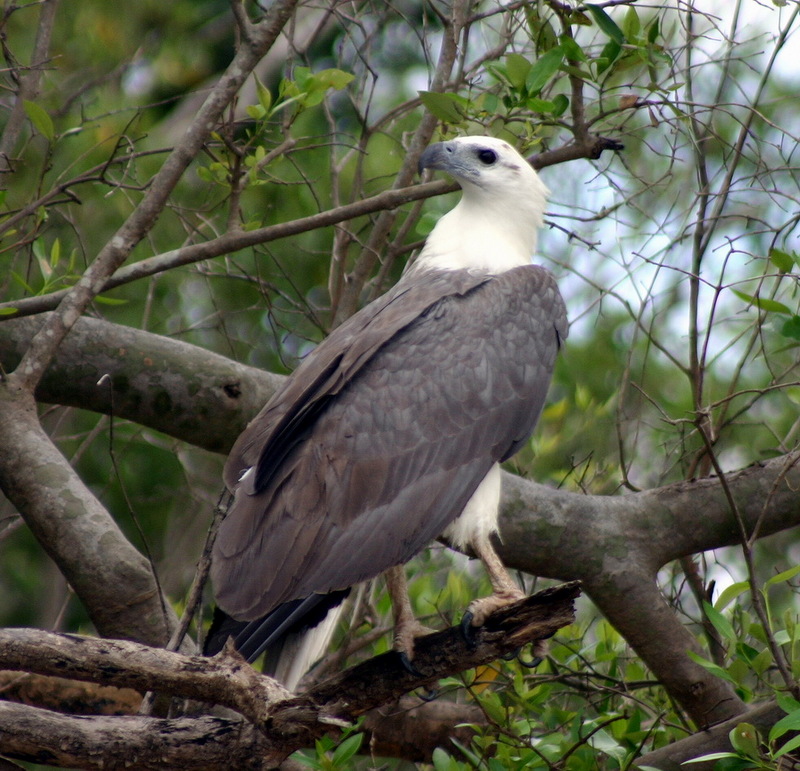|
| 질의: All about animals | 결과: 745번째/929 | |
White-bellied Sea-eagle (Haliaeetus leucogaster) - Wiki
| 제목: | White-bellied Sea-eagle (Haliaeetus leucogaster) - Wiki
| |

| 해상도: 981x946
파일크기: 372883 Bytes
촬영일: 2007:09:01 23:34:35
등록시간: 2007:09:01 23:37:40
|
ERROR : Server Busy(-1105)
ERROR : Server Busy(-1105)
White-bellied Sea-eagle (Haliaeetus leucogaster) - Wiki
White-bellied Sea Eagle
From Wikipedia, the free encyclopedia
[Photo] White-bellied Sea-eagle, Haliaeetus leucogaster (Adelaide River, Darwin). Date 31 May 2007. Author MagicFlute1983 http://commons.wikimedia.org/wiki/User:MagicFlute1983
The White-bellied Sea-eagle (Haliaeetus leucogaster) and also known as the White-bellied Fish-eagle or White-breasted Sea Eagle, is a large bird of prey in the family Accipitridae which also includes many other diurnal raptors such as kites, buzzards and harriers.
It is resident from India through southeast Asia to Australia on coasts and major waterways. This large eagle is very distinctive. The adult has white head, breast underwing coverts and tail. The upperparts are grey and the black underwing flight feathers contrast with the white coverts. The tail is short and wedge-shaped as in all Haliaeetus species.
Its closest relative is the little-known Sanford's Sea-eagle of the Solomon Islands. These form a species pair, and as usual in sea eagle species pairs, as opposed to the dark-headed Sanford's, the White-bellied Sea-eagle has a white head. Talons, bill, and eyes are dark as in all Gondwanan sea eagles. This species pair has at every age at least some dark colouration in its tail, though this may not always be clearly visible in this species. Although they differ much in appearance and ecology, their ancestors diverged less than one million years ago (Wink et al., 1996).
Description
The White-bellied Sea-eagle is the second largest bird of prey found in Australia. The largest is the Wedge-tailed Eagle, Aquila audax, which stands up to 1m. The Wedge-tailed Eagle is mostly brown, with a wedge-shaped tail.
It is white on the head, rump and underparts and dark grey on the back and wings. In flight the black flight feathers on the wings are easily seen when the bird is viewed from below. The large, hooked bill is grey with a darker tip, and the eye is dark brown. The legs and feet are cream-white, with long black talons (claws). The sexes are similar. Males (around 75cm in height) are slightly smaller than females (up to 85cm). The wingspan is about 2 m.
Young Sea-eagles are brown when juveniles then gradually come to resemble adults, acquiring the complete adult plumage by their fourth year.
Distribution and habitat
White-bellied Sea-eagles are a common sight in coastal and near coastal areas of Australia. Birds form permanent pairs that inhabit territories throughout the year. Their loud "goose-like" honking call is a familiar sound, particularly during the breeding season. Birds are normally seen, perched high in a tree, or soaring over waterways and adjacent land.
In addition to Australia, the species is found in New Guinea, Indonesia, China, south-east Asia and India.
Food and feeding
The White-bellied Sea-eagle feeds mainly off aquatic animals, such as fish, turtles and sea snakes, but it takes birds and mammals as well. It is a skilled hunter, and will attack prey up to the size of a swan. They also feed on carrion such as sheep and fish along the waterline. They harass smaller birds, forcing them to drop any food that they are carrying. Sea-eagles feed alone, in pairs or in family groups.
Nesting
It nests, usually close to other White-bellied Sea-eagles, in large nests in trees or on coastal cliffs. Normally two eggs are laid.
http://en.wikipedia.org/wiki/White-bellied_Sea_Eagle
| The text in this page is based on the copyrighted Wikipedia article shown in above URL. It is used under the GNU Free Documentation License. You may redistribute it, verbatim or modified, providing that you comply with the terms of the GFDL. |
|
댓글 |
|---|
| | 손님 |
|
| so cool |
| | 손님 |
|
| The white-bellied sea eagle or white-breasted sea eagle (Haliaeetus leucogaster) is a large diurnal bird of prey in the family Accipitridae. Resident from India and Sri Lanka through Southeast Asia to Australia on coasts and major waterways, Haliaeetus leucogaster breeds and hunts near water, and fish form around half of its diet. |
| | 손님 |
|
Scientific Name: Haliaeetus leucogaster (Gmelin, 1788)
Common Names: White-bellied Sea-eagle, White-bellied Fish-Eagle, White-breasted Sea Eagle
French: Pygargue blagre; German: Weißbauch-Seeadler; Spanish: Pigargo oriental
Taxonomy: Falco leucogaster J. F. Gmelin, 1788, no locality = Java. |
^o^
동물그림창고 똑똑전화 누리집
^o^
|
|
|